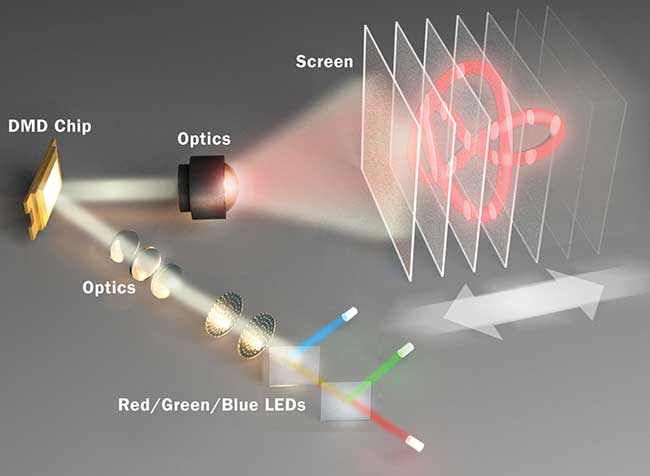Smaller pixels, better optics result in brighter, higher-contrast images from today’s MEMS-based displays.
 When it comes to microelectromechanical systems (MEMS)-based displays, what’s old is new — and now the only game in town. The old, and now only, technology involves projectors, which exploit MEMS chips to create images by bouncing light off either an array of tiny mirrors or a single microscopic mirror. Some of these displays are as big as movie screens. Others are small, near-eye displays. Still others are in-between, such as head-up displays in cars.
What are no longer around, at least commercially, are display technologies based on MEMS interferometric modulators and shutters, such as Qualcomm Inc.’s Mirasol and Pixtronix. San Diego-based semiconductor and telecommunications equipment maker Qualcomm quietly abandoned its MEMS-based display efforts in mid-2015 after years of trying to develop a viable business.
“The main problem was that they compete against LCD flat panels, which have been in huge volume production for a long time. MEMS flat panel displays are much more expensive to manufacture,” said Jérémie Bouchaud, senior principal analyst for MEMS & Sensors at market and technology research firm IHS Markit Ltd.
The abandoned technology did create high-quality images, consume little power and work in bright sunlight — all important attributes for mobile applications. In the end, though, the price differential proved too much, Bouchaud said.
Projection technologies, on the other hand, are still going strong, with the market forecast to grow from $823 million in 2015 to $1.02 billion in 2019 according to IHS Markit. Bouchaud said that growth will be due to an expansion of picoprojectors. These attach to or are part of a phone, tablet or computer. They create a display on a nearby wall or other surface that can be viewed by a group.
When it comes to microelectromechanical systems (MEMS)-based displays, what’s old is new — and now the only game in town. The old, and now only, technology involves projectors, which exploit MEMS chips to create images by bouncing light off either an array of tiny mirrors or a single microscopic mirror. Some of these displays are as big as movie screens. Others are small, near-eye displays. Still others are in-between, such as head-up displays in cars.
What are no longer around, at least commercially, are display technologies based on MEMS interferometric modulators and shutters, such as Qualcomm Inc.’s Mirasol and Pixtronix. San Diego-based semiconductor and telecommunications equipment maker Qualcomm quietly abandoned its MEMS-based display efforts in mid-2015 after years of trying to develop a viable business.
“The main problem was that they compete against LCD flat panels, which have been in huge volume production for a long time. MEMS flat panel displays are much more expensive to manufacture,” said Jérémie Bouchaud, senior principal analyst for MEMS & Sensors at market and technology research firm IHS Markit Ltd.
The abandoned technology did create high-quality images, consume little power and work in bright sunlight — all important attributes for mobile applications. In the end, though, the price differential proved too much, Bouchaud said.
Projection technologies, on the other hand, are still going strong, with the market forecast to grow from $823 million in 2015 to $1.02 billion in 2019 according to IHS Markit. Bouchaud said that growth will be due to an expansion of picoprojectors. These attach to or are part of a phone, tablet or computer. They create a display on a nearby wall or other surface that can be viewed by a group.
Member Exclusive: To read the complete article, please Login or Register